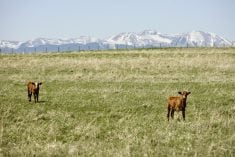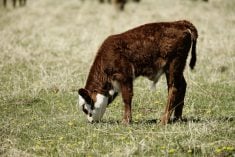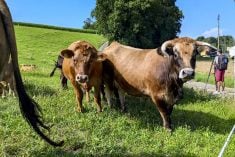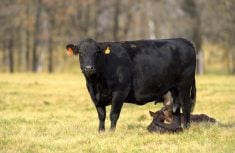Calving time is always a busy and rewarding time of the year. Producers are checking heifers and cows several times a day watching for signs of difficult births, like a breech calf that may require assistance or, in the event of twins, ensuring a mother cow is suckling both calves. These weeks are tiring and stressful but seeing a mother cow lick and nudge a healthy newborn calf up onto its legs, watching it take its first steps and start to suckle the colostrum-rich milk that fills out its belly, provides a sense of satisfaction like no other. It is a time of optimism for the year ahead.
Read Also

The Canadian Cattle Association’s international advocacy efforts
Global ag policies affect Canadian food policy, so the Canadian Cattle Association participates in international and domestic forums
The Canadian Cattlemen’s Association (CCA) is hard at work to ensure producers have the operating environment that creates the opportunities that enable them to continue raising high-quality Canadian beef. These efforts come at an exciting time in Canadian agriculture and are yet another reason for optimism.
The Minister of Finance’s Advisory Council on Economic Growth cited Canada’s agri-food industry as the case study for strategic investment into innovation and skills development in its most recent recommendations to the government. Both the council and Federal Budget 2017 noted that Canadian agriculture is well positioned to take advantage of growing international demand for food given the country’s resources, research strengths and “strong network of entrepreneurs.”
The CCA’s active involvement in climate change policy reflects the strength of our research and commitment to environmental stewardship. Canada’s beef industry attributes just 3.2 per cent to the nation’s total greenhouse gas (GHG) footprint, while contributing $33 billion to the economy. Through research and innovation Canadian beef has one of the lowest GHG footprints per unit of production in the world at 12.0 kg CO2 equivalent per kilogram of live weight, less than half of the world average. Canadian rangelands utilized by the beef industry — including some of the last stands of native grasslands, home to thousands of different species — store substantial amounts of carbon (1.5 billion tonnes).
In April, the CCA appeared before the Standing Senate Committee on Agriculture and Forestry to demonstrate how sustainable beef production can be an effective partner to achieving Canada’s economic and environmental targets. In addition to highlighting the fact that Canada’s beef production GHG footprint has already been reduced by 15 per cent since 1981, the CCA indicated the desire to prevent the further loss of grasslands going forward. The committee heard that GHG emissions could be cut by up to 20 per cent through uptake of mitigation strategies and another five per cent could be cut from reducing food waste by half through investing in five key areas:
- Invest in increasing productivity.
- Support the enhancement of resiliency to climate change.
- Support the mitigation of GHG emissions.
- Support national and international climate change dialogue and action.
- Measure and monitor the GHG footprint of Canadian agriculture.
The CCA provided suggested avenues to accomplish these goals, including continuation of the Beef Science Cluster and further investment in programs that support research, innovation and knowledge transfer regarding practices that reduce the environmental footprint of beef production, and supporting the creation and further development of payment for ecosystem services programs.
With the federal government’s commitment to carbon pricing, the CCA recommends agriculture be exempt from any carbon pricing scheme and assurances that special care be taken to correct the direct and indirect impacts. Canadian agriculture is already a global leader in sustainable production, and as our products are highly traded commodities, the CCA recommends that primary agriculture, and meat and food processing be exempt to mitigate potential competitiveness issues.
The CCA appeared before the House Agriculture Committee with perspective on the amendments to the Health of Animals Regulations: Transportation of Animals Act. Canadian research found that 99.95 per cent of animals on a longer haul of over four hours reach their destination injury free and 99.98 per cent of animals on a short haul less than four hours reach their destination injury free. Given the high prevalence of positive outcomes delivered by industry today, it is crucial that any regulatory change also contribute to real welfare improvements. We outlined aspects of the regulatory proposal of concern to industry. It is the CCA’s position that any regulatory change needs to be based on scientific evidence conducted under Canadian conditions, and, wherever possible, use outcome-based guidelines that focus on the animal.In April I also had the opportunity to meet with International Trade Minister François-Philippe Champagne in Ottawa as part of a roundtable session with Canadian Agri-Food Trade Alliance members. Export opportunities for Canadian agriculture and how the sector will continue to contribute to Canada’s economic growth were discussed. There was considerable conversation about the importance of implementing the trade agreements already negotiated with Europe and the Asia-Pacific region. For Europe, I reminded the minister that we must continue the efforts to resolve regulatory barriers to create genuine opportunity for Canadian beef exporters. I highlighted the need to remain vigilant in protecting our access to the U.S., the largest export market for Canadian beef and live cattle. The CCA supports the government’s strategy of engaging deeply with the U.S. to generate awareness of the value of the Canada-U.S. trade relationship, as this was key to achieving the repeal of U.S. country-of-origin labelling (COOL).
Until next time.
















